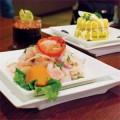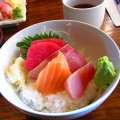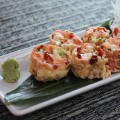I’ve had my fill of paeans to Steve Jobs, but I must toss one more bit of praise onto the heap: The man had good taste in food.
Jobs’ favorite Japanese restaurant was Jin Sho in Palo Alto. He ate a series of meals with friends and associates at the restaurant shortly before he died. I had walked by the restaurant several times, but I had never checked it out. After hearing about Jobs’ meals there, I wanted to try it.
Given Jobs’ keen sense of design and style, I can understand why he liked the restaurant. It’s a simple place with a small dining room and a long sushi bar. Jobs’ favorite seat was at the bar, where he could chat with chefs Noriomi Kaneko and Ichiro Takahashi and ask them about the fish.
And they know their fish. Both are vets of Nobu in New York City; the flagship restaurant of sushi impresario Nobu Matsuhisa, owner of the international chain of high-end Japanese restaurants that bear his name.
What sets the restaurant apart is the variety of fish Jin Sho serves and its less-than-traditional approach. Jin Sho offers a bit of everything: sushi and sashimi, rolls, noodles, tempura and some decent desserts. The restaurant also serves some border-crossing appetizers that really shine.
As you peruse the menu, one of the first things you’ll notice is the depth of the fish available. Jin Sho sources its fish from IMP and True World, the two fish wholesalers that dominate the sushi business. Virtually every sushi bar buys from these two outlets, but not every place goes as deep as Jin Sho.
There are standards like yellowtail, salmon and eel of course, but the menu invites you to plumb the depths of the world’s oceans and try seasonally available items like jackknife clam, Japanese sea perch, sakura shrimp and firefly squid. And like any good sushi bar, there are other items not listed on the menu. Just let one of the itames (sushi chefs) know what’s new and exciting, and you will be steered in the right direction.
On one of my visits, Jin Sho was serving red barracuda and alfonsino, two uncommonly buttery and silken fish that defined fresh and delicious. The fish was sliced evenly, beautifully, and fit perfectly over the rice with nothing flopping over the edge. It was gone in two bites.
Jin Sho’s reverence for ingredients extends to the often overlooked rice and vinegar. The creaminess of the rice and the deep, rich flavors of the vinegar make the rice more than a fish-delivery device.
For me, the best bet is to order the omakase, a chef-picked selection of five nigiri sushi, miso soup and dessert. The lunch version is $38.50. Dinner is more, and you can of course add more fish to the order. Just tell your server or the itame what you like, and he’ll build a platter just for you.
Like Nomo, Jin Sho serves sushi with a Peruvian influence. Peru has a large ethnic Japanese population, and the chile peppers and chile-based sauces common to Peruvian cuisine have a natural affinity to the clean flavors of Japanese food.
The tiradito ($11.25) is a classic Peruvian dish that gets a Jin Sho spin. Tiradito is like ceviche but with bigger slices of fish. Here it’s paired with a creamy, fruity aji panka sauce, a classic Peruvian chile pepper sauce. The addition of yuzu and cilantro ups the flavor even more.
One of my favorite dishes is the Jin Sho salsa ($12.50). It’s similar to tuna tartar, but the addition of cubed avocado, candy sweet cherry tomatoes, cucumber and a savory, tangy and delicious sauce elevates it to something else.
The new-style sashimi ($11.50) is another winner. Made with either stripped bass marinated in garlic and ginger, thin slices of the fish are fanned out on a plate and dribbled with yuzu-flavored soy sauce and hot sesame oil.
Jin Sho has a long list of rolls. The volcano roll ($11.75), made with salmon and spicy mayonnaise, is finished off in the oven and looks like it’s coated in melted, toasted cheese.
Seaweed salads have become sushi bar standards, but Jin Sho’s ($7.75) rises above most others for its selection of top-shelf ingredients: wakame, lacy red and tosaka seaweed and a new one for me, mekabu, the gooey spores of wakame. The briny, nutty-tasting ingredient is much better than it sounds.
For dessert, there’s the standard green tea and sesame seed ice cream. The standout for me was the crustless, thin, but wonderfully rich green-tea cheesecake. There’s also a fine list of sake.
So, thanks, Steve Jobs; for my computer, my iPod and for one of my new favorite Japanese restaurants. Your sense of taste and style lives on.

 Opera San Jose: ‘Pagliacci’ & ‘La voix humaine’
Opera San Jose: ‘Pagliacci’ & ‘La voix humaine’  Fight Preview: UFC at HP Pavillion
Fight Preview: UFC at HP Pavillion 


